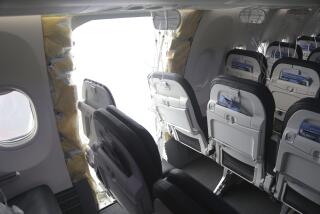FAA Studies Closer-Exit Proposal for Large Jets
- Share via
The Federal Aviation Administration has proposed that on large jets operated by American carriers exits be not more than 60 feet apart and that passengers’ seats be no farther than 30 feet from an exit.
The FAA will accept public comments on the proposal through Dec. 21.
Many jet passengers pay scant attention to the location of exits, but it’s a good idea to know which direction to head and about how far to go. Counting the number of rows from an exit is also a good idea in case the plane’s lights go out.
This proposal, if adopted, would not affect planes now in service, due to the high cost of relocating and installing exits. Only new jets would be affected.
Uniform Exits
Current regulations, dating from 1967, don’t specify a maximum distance between emergency exits, or between seats and exits--only that exits be spaced uniformly along the cabin. It was felt at the time that such a system, based on the jet designs of the period, would produce reasonable seat-to-exit and exit-to-exit distances. The 30-to-60-foot provisions were considered industry standards, an FAA spokesman said.
Most of the narrow-body jets and early wide-body planes conform to the new proposal. For example, original versions of the Boeing 747, the McDonnell Douglas DC-10 and the Lockheed L-1011 have a maximum exit-to-exit distance of 44 to 50 feet. Narrow-body jets typically had shorter distances.
While no U.S. airline uses aircraft with emergency exits more than 60 feet apart, some foreign carriers may. Under this proposal, domestic airlines buying or leasing any of these foreign-owned jets would not be allowed to use these planes unless they were modified to satisfy the new rule.
But new jets and derivatives of existing jets on the drawing boards could have more than 80 feet between exits, an FAA spokesman said: “Designs of the newer jets are not following these general guidelines.”
If approved, the proposal would have its greatest effect on Boeing 747s. Some B-747 operating certificates have been amended to permit deletion of a pair of emergency exits, reducing the jet’s weight by about 600 pounds and improving fuel efficiency.
Opponents say the major factor in evacuating a plane is the number of passengers lined up at the exits and how fast they get out, not the escape-path distance.
A key counter-argument is that, in an emergency, the jet may be structurally damaged, thus necessitating greater access to exits. For example, the cabin floor may not be level and the lights may go out. Aisles can be obstructed with debris and carry-on items.
The cabin may be filled with smoke, and studies have shown that fire and toxic smoke can kill more passengers than the impact in some crashes. Landing-gear collapse and water submersion may also make long escape paths more dangerous, the FAA says.
Fires Block Exits
Exits may be made unusable by pool fires, which are created when spilled fuel collects. In such cases, the FAA says, only a few seconds can be critical in escaping the aircraft.
Other factors are confusion and panic. Some passengers may also be injured and need more time to reach an exit.
The FAA says the typical passenger has great difficulty negotiating an inclined aisle without being able to use his hands for support against seat backs to maintain balance. Add poor visibility due to smoke and aisle obstructions, and the time it takes passengers to reach exits can be greatly slowed.
The FAA also claims that its proposal wouldn’t place U.S. airlines at a disadvantage with international carriers, or have a measurable effect on trade. While some foreign airlines have deleted exits, the FAA doesn’t expect this practice to continue to any great extent, because virtually all carriers fly at less than their maximum seating capacities.
The FAA’s exit proposal arose from studies made by the Emergency Evacuation Task Force, which was formed in September, 1985, by the FAA.
Comments on the emergency exit proposal should be sent to: Federal Aviation Administration, Office of the Chief Counsel, Docket No. 25419, 800 Independence Ave. S.W., Washington, D.C. 20591.
More to Read
Inside the business of entertainment
The Wide Shot brings you news, analysis and insights on everything from streaming wars to production — and what it all means for the future.
You may occasionally receive promotional content from the Los Angeles Times.










